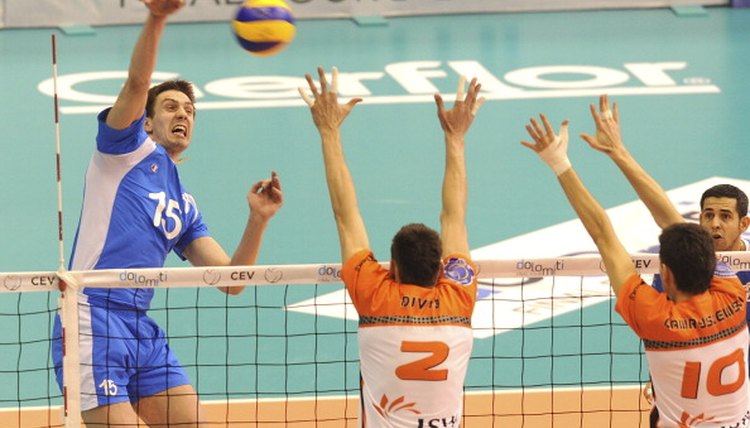The Types of Defense in Volleyball

There are two predominant defensive concepts in volleyball: perimeter defense and rotational defense. In addition to those two basic styles, man-up or "red" defense has regained some popularity. Teams may adjust each of these defensive schemes to fit their talent and match-up against their opponent. Each defensive type has particular strengths and weaknesses.
Rotational Defense
As the name suggests, players rotate into their "read" position based on how the play is developing. For instance, if the opponent sets to its outside hitter, the middle front and right-side front players block. The outside blocker stays home and covers the rest of the front court. The right back defender edges up behind the blockers to pick up balls tipped over them. The left back is responsible for the deep angle ball. The middle back rotates to the same sideline where the ball was set. The rotation changes if the opponent sets to its right-side hitter or the middle hitter.
Perimeter Defense
In the perimeter defense, players start in the same base position as in rotational defense. But as the play unfolds, there is less movement into the "read" positions. This is a good defense to dig out hard-driven balls. It is more vulnerable to tips, relying on players to take away those plays with their athletic ability. As such, it is more popular with men's teams with more size and range.
Man Up or "Red" Defense
As the name suggests, the man up or "red" defense moves a back player up to support the front three players. This protects the middle of court from middle attacks and tips. It keeps the wing players deep. This formation minimizes the movement from base position to defensive zone. The deeper base positions allow players to keep most plays in front of them.
Fine-Tuning the Schemes
Within these basic concepts, countless adjustments can be made to suit the ability of the team. Hybrid defensive schemes are common. As volleyball coaching legend Bill Neville once said, "Defense should be designed so that it allows for putting the best diggers in areas that will most often be attacked."
References
Writer Bio
Jeff Gordon has been reporting and writing since 1977. His most recent work has appeared on websites such as eHow, GolfLink, Ask Men, Open Sports, Fox Sports and MSN. He has previously written for publications such as "The Sporting News" and "The Hockey News." He graduated from the University of Missouri-Columbia School of Journalism in 1979 with a bachelor's degree.
